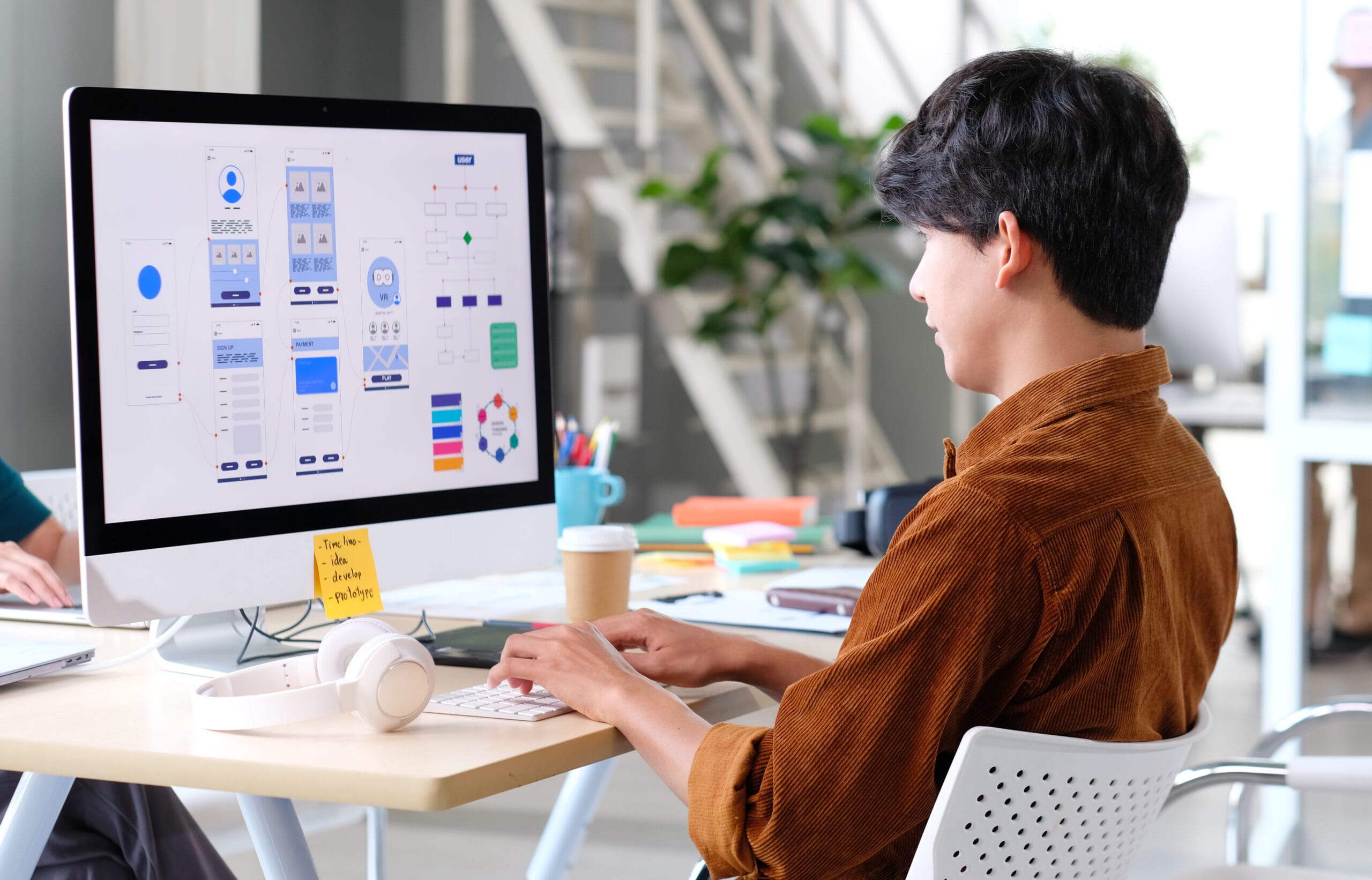Why consistency in branding is the secret weapon of a successful Website Design Agency
The Significance of User Experience in Efficient Web Design Strategies
User experience (UX) functions as a cornerstone in efficient web design methods. It forms exactly how individuals communicate with a site, affecting their fulfillment and likelihood of returning. A properly designed UX can improve involvement through instinctive navigation and receptive layouts. Nevertheless, overlooking these elements might cause irritation and increased bounce prices. Recognizing the ins and outs of UX is important for designers intending to produce compelling electronic experiences that reverberate with diverse target markets. What elements really drive effective user interaction?
Recognizing User Experience and Its Effect On Design
User experience (UX) is frequently perceived as a mere element of web style, it basically shapes exactly how customers engage with a website. UX incorporates all facets of the user's communication, including use, availability, and overall fulfillment. A positive UX cultivates interaction, urging users to explore the site and return in the future. On the other hand, a negative experience can result in aggravation, causing high bounce rates and shed chances for conversion.
Layout components like layout, navigation, and material organization play crucial roles fit this experience. Effective UX layout expects user needs and choices, guaranteeing that information is easily obtainable and aesthetically appealing. Additionally, understanding user actions through analytics can provide beneficial insights, notifying design decisions that enhance usability. Ultimately, an extensive understanding of UX permits designers to create internet sites that not just attract customers but likewise promote purposeful communications that align with business goals and user expectations.
Key Principles of Effective User Experience
Efficient user experience rests on a number of essential principles that boost site capability and engagement. Instinctive navigation design, responsive format fundamentals, and the significance of aesthetic power structure are important elements that contribute to a seamless interaction in between individuals and web content. Understanding these concepts permits developers to create even more user-friendly and accessible electronic atmospheres.
Intuitive Navigating Design
User-friendly navigation layout serves as a critical entrance to their total experience when individuals encounter a web site. Reliable navigating permits customers to easily situate the info they look for, enhancing their interaction with the website. Secret concepts consist of clear labeling, sensible company, and consistent positioning of navigation elements. Tags should be straightforward, enabling individuals to predict the web content they will locate. A well-structured pecking order aids individuals understand the partnership between various sections, assisting them through the internet site effortlessly. Furthermore, responsive food selections and easily available web links add to a fluid experience across tools. By focusing on user-friendly navigation, developers can greatly lower user aggravation and increase engagement, inevitably promoting a positive assumption of the website and its content.
Receptive Layout Essentials
A well-structured navigating system naturally results in the requirement for a responsive layout, which is important in today's diverse electronic landscape. A responsive layout assurances that websites function effortlessly throughout various gadgets, consisting of tablets, desktops, and smartphones. This versatility enhances user experience by enabling material to be visually coherent and conveniently accessible, despite display size. Secret concepts of receptive design include liquid grids, flexible photos, and media queries, which facilitate ideal viewing. In addition, prioritizing touch-friendly elements improves interaction on mobile gadgets. By carrying out a responsive layout, designers can suit customers' needs, minimize bounce prices, and boost engagement. Eventually, a well-executed responsive style cultivates a favorable user experience, encouraging visitors to check out the web site better.
Aesthetic Hierarchy Importance
Aesthetic power structure plays a vital function in leading users through a site, making sure that vital information catches their focus. By strategically utilizing size, spacing, shade, and comparison, developers can create a clear pathway for individuals to comply with. Bigger elements typically attract the eye, indicating their significance, while contrasting shades can highlight contact us to action. Furthermore, constant positioning and group of associated content boost understanding, making navigating user-friendly. Effective use of visual pecking order not only enhances usability however also supports the overall aesthetic of the site, fostering a favorable user experience. When individuals can easily identify one of the most critical information, they are more probable to involve with the content, bring about boosted fulfillment and interaction with the website.
The Function of Functionality in Web Design
Use plays an essential duty in web design, especially through navigating simpleness and adherence to access criteria. Reliable navigation improves user fulfillment by allowing site visitors to find details quickly and with ease. At the same time, meeting ease of access criteria ensures that all customers, regardless of their capabilities, can properly communicate with the web site.
Navigation Simpleness
Simplicity in navigating stands as a foundation of reliable web design, considerably influencing user experience. A structured navigation system permits users to find details rapidly and without effort, lowering irritation and improving fulfillment. Clear labeling and rational framework are necessary elements, leading customers effortlessly via the internet site. Redundant links or overly complex menus can disorient users, leading to click this enhanced bounce prices. Additionally, mobile responsiveness needs to be considered, making sure navigation continues to be simple across gadgets. Minimizing and focusing on crucial web pages clutter better supports user engagement. Efficient navigation not only fosters a favorable experience but likewise motivates individuals to check out the site better, inevitably leading to higher conversion rates. In this regard, navigation simplicity serves as an important factor in the overall effectiveness of web design strategies.
Ease of access Criteria
User involvement is substantially improved when web sites stick to access standards, ensuring that all individuals, regardless of their capacities, can navigate and connect successfully. Compliance with these requirements not just widens the target market however also boosts overall user contentment. Easily accessible style incorporates attributes such as text alternatives for photos, key-board navigation, and adequate color comparison, which assist in use by people with impairments. Furthermore, applying these criteria can favorably impact search engine optimization (SEARCH ENGINE OPTIMIZATION) by enhancing site framework and clarity. As web design evolves, focusing on ease of access ends up being vital in fostering an inclusive electronic setting. By embracing these requirements, developers add to a more equitable internet, eventually driving user commitment and interaction.
Importance of Responsive Layout for User Engagement
As customers significantly gain access to internet sites with a selection of tools, the relevance of receptive style comes to be critical for involving users effectively. Responsive style warranties that a site adjusts seamlessly to different display sizes, providing an ideal viewing experience no matter the device used. This adaptability enhances user involvement by assisting in easier navigation and interaction with material.
When customers encounter a website that is responsive, they are more probable to stay longer, explore even more, and return in the future. A well-designed responsive layout reduces the aggravation commonly related to scrolling and zooming on smaller displays, thereby decreasing bounce rates. Additionally, responsive design can positively affect search engine positions, as online search engine prioritize mobile-friendly sites. In today's electronic landscape, where mobile use proceeds to rise, carrying out receptive layout is not simply valuable, but important for maintaining user involvement and assuring a positive experience throughout all devices.
Enhancing Load Times for Better User Complete Satisfaction

To boost tons times, web developers should prioritize optimizing pictures, leveraging web browser caching, and lessening HTTP demands. In addition, utilizing Material Shipment Networks (CDNs) can quicken content shipment by dispersing it throughout numerous geographic areas. Enhancing code, such as compressing CSS and JavaScript data, further contributes to faster filling rates.
Eventually, a commitment to boosting lots times not only enhances user contentment yet also enhances brand name loyalty and improves the likelihood of repeat check outs. A swift, smooth experience is vital for preserving users and cultivating favorable view it now communications.
The Impact of Visual Power Structure on User Communication
Aesthetic power structure works as a crucial aspect in assisting user interaction on an internet site. By arranging material in a manner that prioritizes details aesthetically, designers can affect just how users involve and navigate with a site. This pecking order is established via various design techniques, including size, color, spacing, and comparison. For example, larger typefaces or vibrant shades accentuate critical elements, such as phone call to activity or headings, while suppressed colors and smaller sized typefaces can indicate secondary details.
Effective visual power structure assists users quickly determine what is essential, decreasing cognitive tons and boosting use. It enables instinctive navigation, making it much easier for users to locate what they require without disappointment. As users connect with a website, a well-structured aesthetic power structure cultivates an extra rewarding experience, ultimately resulting in higher involvement and conversion prices. Designers need to prioritize these concepts to create a effective and user-centered web atmosphere.
Gauging User Experience: Tools and Methods

Regularly Asked Concerns
Exactly How Can I Improve My Internet site's User Experience on a Budget plan?
To boost a web site's user experience on a budget, one can optimize web page tons speed, streamline navigating, apply receptive style, enhance content quality, and collect user feedback for constant refinements, ensuring a gratifying visitor experience.
What Prevail User Experience Errors to Stay Clear Of in Web Design?
Usual user experience mistakes in web design consist of chaotic formats, bad navigation, slow-moving packing times, lack of mobile responsiveness, overlooking access, inconsistent branding, and failing to focus on user comments - Web Design services. Each can significantly hinder general site efficiency
Exactly how Often Should I Update My Web Site for Better User Experience?
Internet sites ought to be updated regularly, ideally every few months, to maintain ideal user experience. Constant updates help address usability concerns, revitalize content, and adapt to altering user demands, making sure the site stays pertinent and appealing.

Can User Experience Effect Search Engine Optimization Rankings on My Internet site?
User experience can substantially affect SEO positions, as online search engine prioritize sites that use seamless navigating, quick filling times, and appealing material. A favorable user experience can cause lower bounce rates and greater search exposure.
What Function Does Access Play in User Experience Layout?
Availability plays a vital function in user experience style by making certain that all individuals, no matter capabilities, can interact and navigate with a web site successfully. This inclusivity enhances total contentment and involvement amongst varied users.
User experience (UX) is commonly perceived as a simple aspect of internet design, it fundamentally shapes how individuals communicate with a website. User involvement is significantly enhanced when web sites stick to ease of access requirements, guaranteeing that all individuals, regardless of their capabilities, can navigate and communicate effectively. Measuring user experience (UX) is necessary for understanding exactly how successfully a website fulfills the requirements of its users. Additionally, functionality testing, where real individuals navigate the website while onlookers keep in mind troubles, offers direct responses on user experience. Typical user experience errors in web design include messy layouts, inadequate navigation, slow-moving loading times, lack of mobile responsiveness, neglecting availability, inconsistent branding, and failing to focus on user responses.